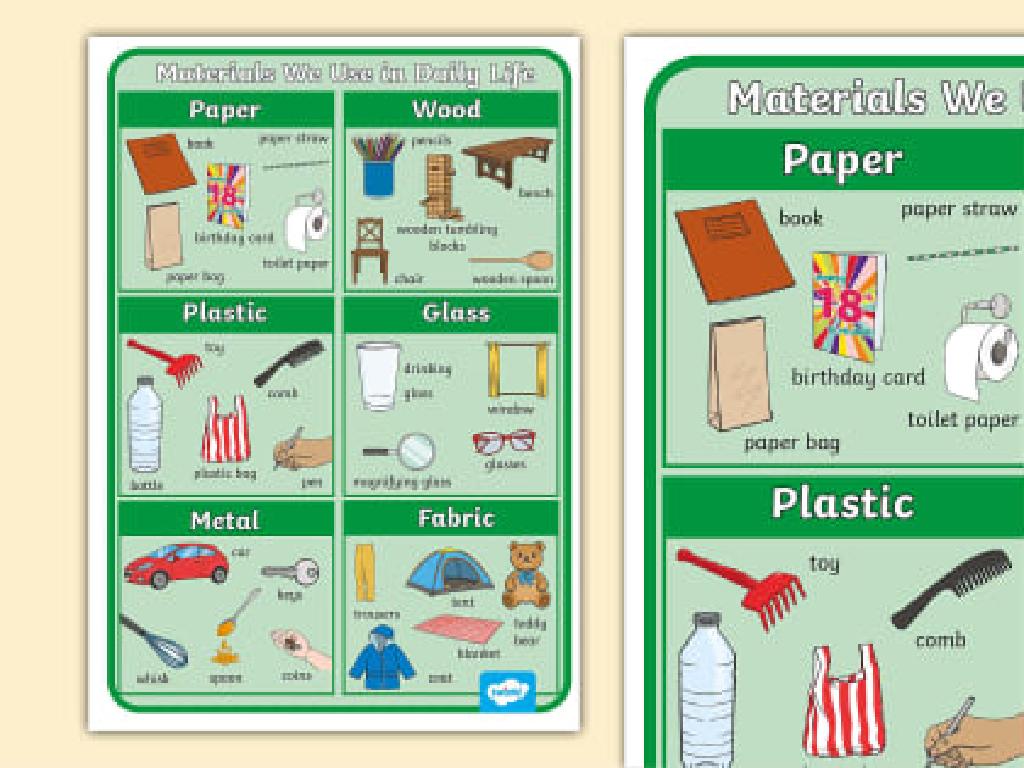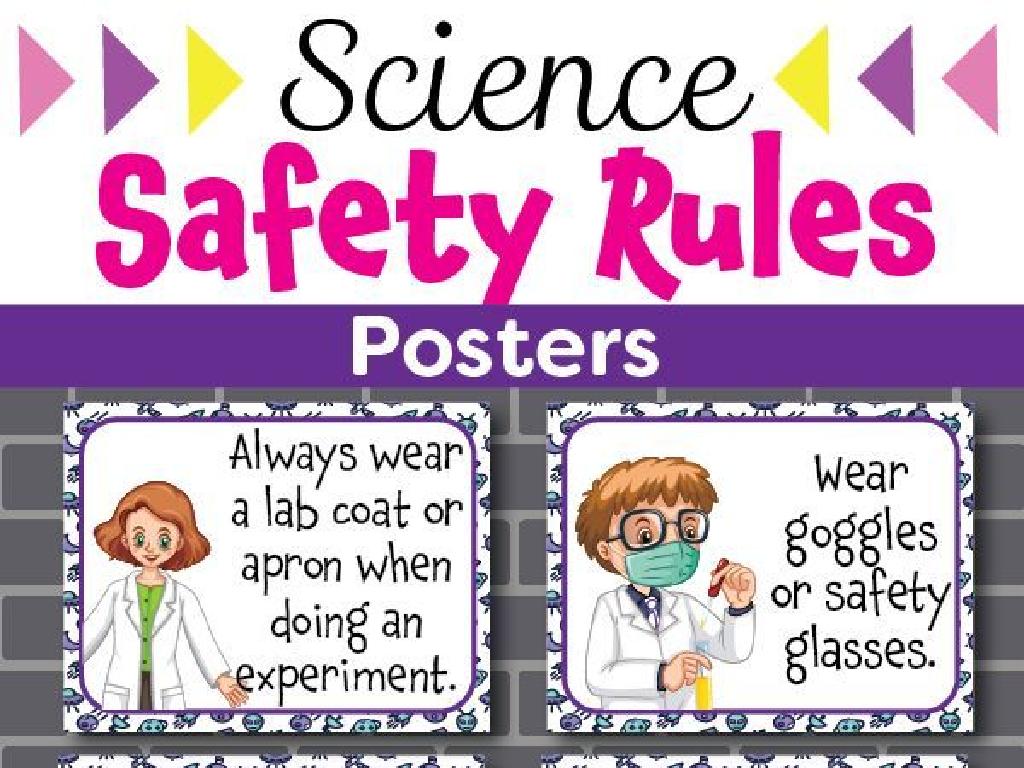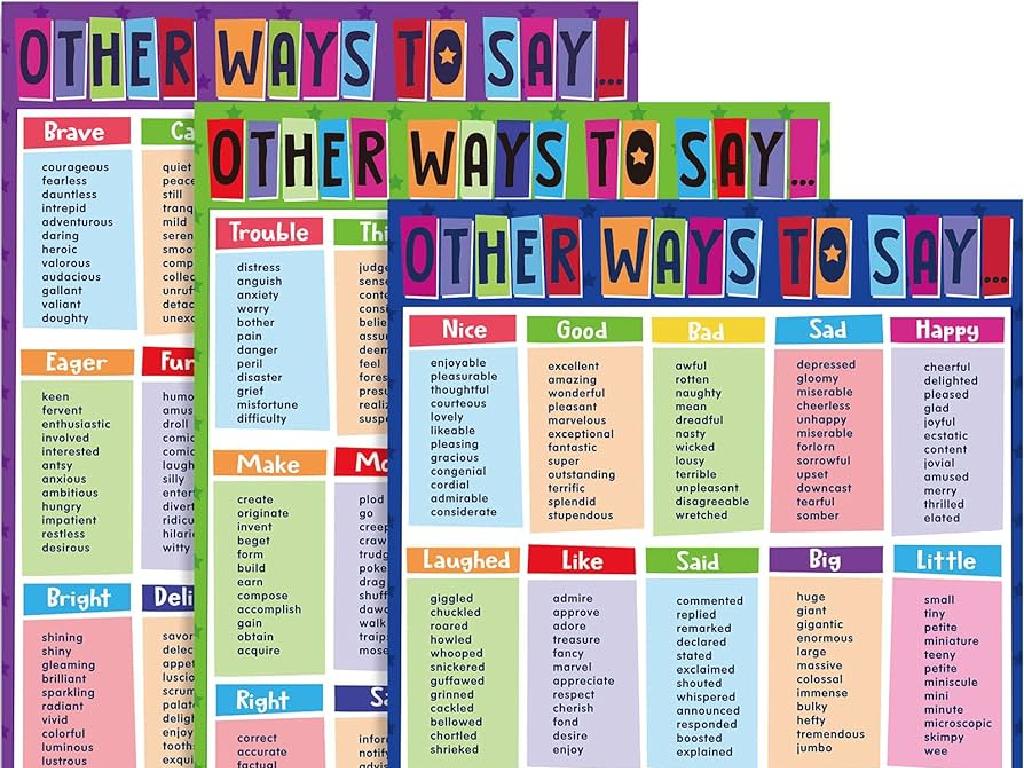Commas With Series, Dates, And Places
Subject: Language arts
Grade: Seventh grade
Topic: Commas
Please LOG IN to download the presentation. Access is available to registered users only.
View More Content
Mastering Commas: Series, Dates, and Places
– Commas organize and clarify text
– Use commas to separate items in a series
– For example: I need eggs, milk, and bread.
– Commas in dates and addresses
– Dates: July 4, 1776, is significant. Addresses: Send it to 123 Main Street, Springfield, IL.
– Why proper comma use is crucial
– They prevent misreading and connect ideas smoothly.
|
This slide introduces the importance of commas in writing, focusing on their use in series, dates, and places. Emphasize how commas help in organizing text and making the meaning clear. Show how a list of items requires commas for separation, and provide an example. Explain the standard format for writing dates and addresses with commas. Discuss why commas are essential: they help avoid confusion and ensure that the reader understands the writer’s intended meaning. Encourage students to think of commas as traffic signals in writing that guide the reader through the sentence.
The Role of Commas in Writing
– Commas clarify sentence meaning
– E.g., ‘Let’s eat, Grandma!’ vs ‘Let’s eat Grandma!’
– Indicate a pause in sentences
– Prevent confusion in text
– Without commas, meanings twist: ‘The panda eats shoots and leaves’ vs ‘The panda eats, shoots, and leaves.’
– Essential for correct structure
|
This slide introduces the importance of commas in writing. Commas are crucial punctuation marks that help clarify the meaning of sentences by indicating natural pauses and separating elements. Without proper comma usage, sentences can become confusing or misleading, changing the intended message. For example, the famous book title ‘Eats, Shoots & Leaves’ highlights how the meaning shifts dramatically with and without commas. Instruct students to practice using commas in lists, dates, and places to enhance their writing clarity. Provide exercises where they add commas to sentences and compare how the meaning changes.
Commas in a Series, Dates, and Places
– Use commas to list items
– Example: eggs, milk, bread, cheese
– Separates items like a shopping list
– The Oxford Comma explained
– The last comma before ‘and’ or ‘or’ in a series
– Practice: Write your own list
– Use items you’d pack for a trip
|
This slide introduces the use of commas in a series, which is a fundamental aspect of punctuation in writing. Students should understand that commas act as separators in a list, making the text clearer and easier to read. The Oxford Comma, also known as the serial comma, is particularly important to note as it can change the meaning of a sentence. Provide examples with and without the Oxford Comma to illustrate its function. For practice, encourage students to write a list of items they would pack for a vacation, using commas appropriately. This exercise will help reinforce their understanding of how commas are used to separate items in a series.
Practice: Commas in a Series
– Collaboratively create a list
– Write a sentence with hobbies
– List your favorite hobbies in a sentence, separated by commas
– Discuss comma importance
– Reflect on how commas help avoid confusion
– Observe meaning changes
|
This slide is for a class activity focused on the use of commas in a series. Start by engaging the class in creating a list together on the board. Then, instruct each student to write a sentence that lists their favorite hobbies, using commas to separate each hobby. After writing, initiate a discussion on how the commas help clarify the sentence and how omitting them could change the meaning or create confusion. For example, ‘I enjoy reading, cooking, and painting’ versus ‘I enjoy reading cooking and painting.’ The latter could imply that the student enjoys reading cookbooks and painting, rather than three separate hobbies. This activity will help students understand the practical use of commas in writing.
Commas with Dates
– Commas separate day and month
– Also, separate date from year
– Example: July 4, 1776, significance
– July 4, 1776, marks U.S. Independence Day
– Use commas within sentences
– After the year, add a comma if the sentence continues
|
This slide focuses on the rules for using commas in dates. Students should learn that commas are used to separate the day from the month and the date from the year. It’s crucial to provide examples to illustrate this, such as ‘July 4, 1776, is a significant date in U.S. history.’ Additionally, when a date is written within a sentence, a comma should follow the year if the sentence continues. For instance, ‘On July 4, 1776, the United States declared its independence, a pivotal moment in history.’ Encourage students to practice by writing dates with commas and to check their understanding by explaining why commas are used in these instances.
Practice: Commas with Dates
– Writing today’s date in context
– Class activity: Event paragraphs
– Write a paragraph about a historical event or personal experience, and correctly place the comma in the date.
– Include event dates correctly
– For example, July 4, 1776, is when the United States declared independence.
– Share and review as a class
|
This slide is designed to provide students with practice on using commas in dates within sentences. Start by demonstrating how to write today’s date in a sentence, explaining the placement of the comma. For the class activity, instruct students to write a short paragraph about an important event, ensuring they include the date it occurred with the correct comma usage. This could be a historical event or a personal memory. Encourage creativity and personal connection to the material. After writing, students will share their paragraphs with the class or in small groups to review and learn from each other’s comma placements. This interactive activity will help reinforce the rules for comma usage with dates and enhance their writing skills.
Commas with Places
– Separate city and state with a comma
– Add a comma after the state in a sentence
– Example: Orlando, Florida, is beautiful
– Like: ‘I visited Orlando, Florida, last summer.’
– Remember the comma if the sentence continues
– E.g., ‘I live in Orlando, Florida, and I enjoy the weather.’
|
This slide focuses on the use of commas when writing about places, specifically cities and states. It’s important for students to understand that a comma is used to separate the city from the state, and another comma follows the state if the sentence continues. This rule helps clarify the sentence structure and improves readability. Provide students with additional examples and have them practice by writing sentences that include city and state, ensuring they place commas correctly. Encourage peer review to foster collaborative learning and reinforce the concept.
Class Activity: Commas with Places
– Write about your dream destination
– Include the city and state/country
– Use commas to separate them
For example: I would love to visit Paris, France.
– Share your sentence with the class
|
This activity is designed to help students practice using commas when writing about places. Students will think of a place they would like to visit and write a sentence that includes the city and state or country, using commas appropriately. For instance, ‘I want to go to Tokyo, Japan, to see the cherry blossoms.’ After writing, students will share their sentences with the class, providing an opportunity to see a variety of examples and ensuring that they understand how to use commas in this context. As they share, correct any mistakes and explain why the commas are used in those places. This will reinforce the lesson and give students confidence in their punctuation skills.
Class Activity: Comma Hunt
– Find commas in a favorite book
– Share examples with the class
– Discuss commas’ role in understanding
– How do commas clarify series, dates, and places?
– Reflect on the use of commas
– Think about reading ease and clarity with commas
|
This activity is designed to engage students with practical examples of comma usage from literature they enjoy. Students will search for commas used in series, dates, and places within their favorite books, which will help them understand the importance of punctuation in written text. Encourage them to consider how commas affect the flow and comprehension of sentences. During the sharing session, facilitate a discussion on how commas contribute to the clarity of the text. Possible activities: 1) Students can list the examples they found. 2) Create a game where students guess the missing comma in a sentence. 3) Have students rewrite sentences without commas to see the difference. 4) Pair students to compare their findings. 5) Create a classroom comma usage chart with their examples.
Concluding Commas: Series, Dates, & Places
– Recap: Commas in series, dates, places
– Importance of correct comma usage
– Homework: Craft a short story
– Include at least 5 examples of each comma use
– Incorporate commas in lists, dates, places
– Ensure commas clarify meaning and avoid confusion
|
As we wrap up today’s lesson, remember that commas are crucial in writing for clarity and avoiding misunderstandings. They help readers understand the separation of items, the flow of time, and the location of events. For homework, students are to write a creative short story that includes commas in series, dates, and places. This will reinforce their understanding and application of the rules. Encourage creativity, but emphasize the importance of correct comma placement. Provide examples of common mistakes to avoid and remind them to proofread their work. In the next class, we’ll review some of the stories and discuss the comma usage in them.





